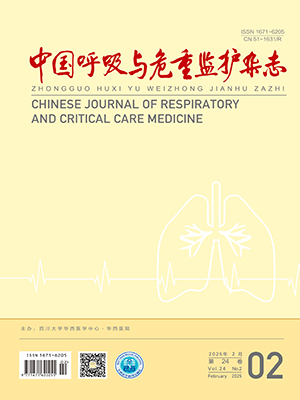| 1. |
贾文婷, 万秋风, 徐思成, 等. 重症社区获得性肺炎高龄患者有创通气序贯无创通气的时机探讨. 中华危重病急救医学, 2020, 32(3): 324-329.
|
| 2. |
Lee JH, Rehder KJ, Williford L, et al. Use of high flow nasal cannula in critically ill infants, children, and adults: a critical review of the literature. Intensive Care Med, 2013, 39(2): 247-257.
|
| 3. |
中华医学会呼吸病学分会呼吸危重症医学学组, 中国医师协会呼吸医师分会危重症医学工作委员会. 成人经鼻高流量湿化氧疗临床规范应用专家共识. 中华结核和呼吸杂志, 2019, 42(2): 83-91.
|
| 4. |
侯晓雯, 时景璞, 陈欣. 在Meta分析中如何利用中位数、极差和样本量估算均数、标准差. 中国循证医学杂志, 2015, 15(4): 484-487.
|
| 5. |
王丹, 翟俊霞, 牟振云, 等. Meta分析中的异质性及其处理方法. 中国循证医学杂志, 2009, 9(10): 1115-1118.
|
| 6. |
胡佚凡, 高锦, 李娜, 等. 有创ETI-MV后HFNC与NIPPV治疗老年COPD合并呼吸衰竭的临床效果分析. 重庆医学, 2022, 51(11): 1908-1911.
|
| 7. |
杨小雪, 卓越, 丁伟超, 等. 慢性阻塞性肺疾病急性加重机械通气患者序贯HFNC与NPPV的疗效比较. 国际麻醉学与复苏杂志, 2022, 43(1): 29-33.
|
| 8. |
曹鹏, 凌冰玉, 徐艳, 等. 有创–高流量氧疗与有创–无创通气序贯治疗慢性阻塞性肺疾病并严重呼吸衰竭的随机对照研究. 中国呼吸与危重监护杂志, 2021, 20(6): 388-395.
|
| 9. |
方国强, 万秋风, 田雅洁, 等. AECOPD致严重呼吸衰竭患者早期拔管后序贯经鼻高流量湿化氧疗与无创正压通气的优劣比较. 中华危重病急救医学, 2021, 33(10): 1215-1220.
|
| 10. |
孙章萍, 程志华, 闫福栋. 经鼻高流量湿化氧疗对慢性阻塞性肺疾病并发呼吸功能衰竭患者的价值. 黑龙江医药, 2021, 34(4): 904-907.
|
| 11. |
吴松, 黄世霜, 王香. 序贯经鼻高流量氧疗对COPD机械通气患者血气指标及肺功能的影响. 数理医药学杂志, 2021, 34(10): 1435-1437.
|
| 12. |
席卓娜. 有创机械通气—高流量氧疗序贯治疗慢性阻塞性肺疾病合并呼吸衰竭的临床效果. 临床研究, 2021, 29(8): 104-106.
|
| 13. |
黄静铭, 梁志金, 黄连意. 经鼻高流量氧疗与无创正压通气在AECOPD病人拔管后序贯治疗的效果观察. 循证护理, 2020, 6(6): 565-569.
|
| 14. |
蒋光辉, 毛媛, 唐娅群, 等. 高流量氧疗与无创通气在AECOPD序贯治疗中比较研究. 江西医药, 2020, 55(8): 975-978.
|
| 15. |
陈栋玉, 何磊, 周亮亮, 等. 有创机械通气–高流量氧疗序贯治疗慢性阻塞性肺疾病所致急性呼吸衰竭的临床研究. 中华重症医学电子杂志, 2019, 5(3): 219-224.
|
| 16. |
林怀印, 付会文, 赵智东, 等. 慢性阻塞性肺疾病患者拔管后序贯经鼻高流量氧疗的效果研究. 检验医学与临床, 2019, 16(12): 1646-1649.
|
| 17. |
刘景刚, 杨圣强, 袁继印, 等. 经鼻高流量氧疗序贯治疗慢性阻塞性肺疾病机械通气患者的临床研究. 中华急诊医学杂志, 2019, 28(4): 459-462.
|
| 18. |
於江泉, 郑瑞强, 朱进, 等. 经鼻高流量氧疗在慢性阻塞性肺疾病急性加重患者有创呼吸机序贯治疗中的临床效果. 中华重症医学电子杂志, 2019, 5(3): 213-218.
|
| 19. |
喻正浩, 张瑞, 黄卉, 等. 经鼻高流量湿化氧疗应用于慢性阻塞性肺疾病合并2型呼吸衰竭患者气管插管拔管后的疗效和安全性: 随机对照研究. 第二军医大学学报, 2019, 40(9): 989-994.
|
| 20. |
徐晓翠, 王金柱, 姚惠萍. 经鼻高流量湿化氧疗对COPD患者拔管后再插管及呼吸衰竭的影响. 齐鲁护理杂志, 2018, 24(5): 1-3.
|
| 21. |
张京臣, 吴逢选, 孟琳琳, 等. 慢性阻塞性肺疾病患者拔管后序贯经鼻高流量氧疗的效果及安全性. 中华医学杂志, 2018, 98(2): 109-112.
|
| 22. |
韩晓霖, 刘述平, 刘一诚, 等. 经鼻高流量氧疗对AECOPD患者撤机效果的影响. 湖南师范大学学报(医学版), 2018, 15(1): 145-148.
|
| 23. |
Xu S, Liu X. Sequential treatment of chronic obstructive pulmonary disease concurrent with respiratory failure by high-flow nasal cannula therapy. Am J Transl Res, 2021, 13(4): 2831-2839.
|
| 24. |
Tan DY, Walline JH, Ling BY, et al. High-flow nasal cannula oxygen therapy versus non-invasive ventilation for chronic obstructive pulmonary disease patients after extubation: a multicenter, randomized controlled trial. Critical Care, 2020, 24(1): 489.
|
| 25. |
Jing GQ, Li J, Hao D, et al. Comparison of high flow nasal cannula with noninvasive ventilation in chronic obstructive pulmonary disease patients with hypercapnia in preventing postextubation respiratory failure: a pilot randomized controlled trial. Res Nurs Health, 2019, 42(3): 217-225.
|
| 26. |
江学成. 危重疾病严重程度评分临床应用和意义. 中国危重病急救医学, 2000, 12(4): 195-197.
|
| 27. |
慢性阻塞性肺疾病急性加重诊治专家组. 慢性阻塞性肺疾病急性加重诊治中国专家共识(2023年修订版). 国际呼吸杂志, 2023, 43(2): 132-149.
|
| 28. |
Feng ZZ, Zhang L, Yu HC, et al. High-flow nasal cannula oxygen therapy versus non-invasive ventilation for AECOPD patients after extubation: a systematic review and meta-analysis of randomized controlled trials. Int J Chron Obstruct Pulmon Dis, 2022, 17: 1987-1999.
|
| 29. |
简佳庆, 段凤英, 肖远超, 等. ICU拔除气管插管患者使用经鼻高流量湿化氧疗对比传统氧疗或无创正压通气临床疗效的Meta分析. 中国呼吸与危重监护杂志, 2019, 18(1): 42-50.
|
| 30. |
王辰, 商鸣宇, 黄克武, 等. 有创与无创序贯性机械通气治疗慢性阻塞性肺疾病所致严重呼吸衰竭的研究. 中华结核和呼吸杂志, 2000, 23(4): 212-216.
|




